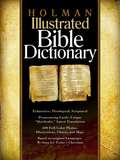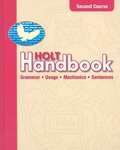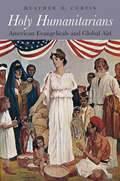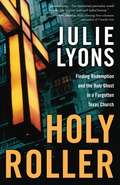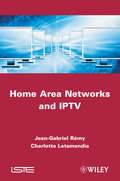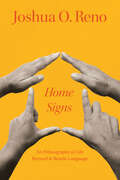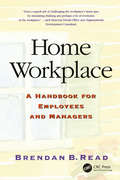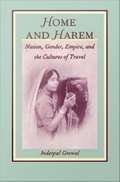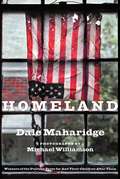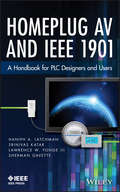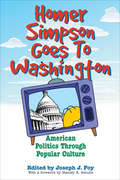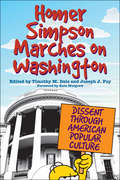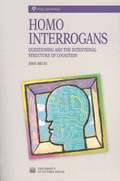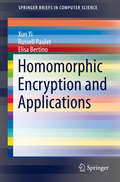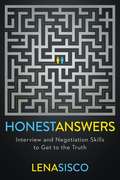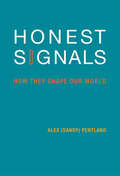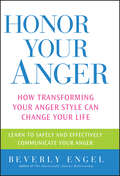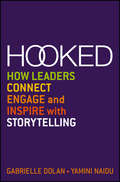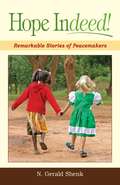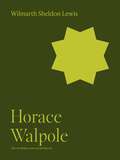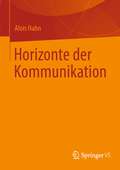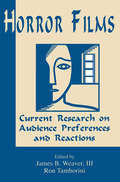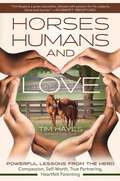- Table View
- List View
Holman Illustrated Bible Dictionary
by Chad Brand Archie England Charles W. DraperRevised and expanded, this best-selling study tool is better than ever! It features 700 color photos, 80 color maps, a pronounciation guide, the latest archaeological excavation information, time lines, extensive cross-referencing, unique scale drawings, and much more.
Holt Handbook Grammar: Usage, Mechanics, Sentences (Second Course)
by John E. WarrinerThis book gives the tools to understand and discuss our own language, to communicate clearly the things we want to communicate, and to develop our own communication style.
Holy Humanitarians: American Evangelicals and Global Aid
by Heather D. CurtisOn May 10, 1900, an enthusiastic Brooklyn crowd bid farewell to the Quito. The ship sailed for famine-stricken Bombay, carrying both tangible relief—thousands of tons of corn and seeds—and “a tender message of love and sympathy from God’s children on this side of the globe to those on the other.” The Quito may never have gotten under way without support from the era’s most influential religious newspaper, the Christian Herald, which urged its American readers to alleviate poverty and suffering abroad and at home. In Holy Humanitarians, Heather D. Curtis argues that evangelical media campaigns transformed how Americans responded to domestic crises and foreign disasters during a pivotal period for the nation. Through graphic reporting and the emerging medium of photography, evangelical publishers fostered a tremendously popular movement of faith-based aid that rivaled the achievements of competing agencies like the American Red Cross. By maintaining that the United States was divinely ordained to help the world’s oppressed and needy, the Christian Herald linked humanitarian assistance with American nationalism at a time when the country was stepping onto the global stage. Social reform, missionary activity, disaster relief, and economic and military expansion could all be understood as integral features of Christian charity. Drawing on rigorous archival research, Curtis lays bare the theological motivations, social forces, cultural assumptions, business calculations, and political dynamics that shaped America’s ambivalent embrace of evangelical philanthropy. In the process she uncovers the seeds of today’s heated debates over the politics of poverty relief and international aid.
Holy Roller: Finding Redemption and the Holy Ghost in a Forgotten Texas Church
by Julie LyonsJulie Lyons was working as a crime reporter when she followed a hunch into the South Dallas ghetto. She wasn’t hunting drug dealers, but drug addicts who had been supernaturally healed of their addictions. Was there a church in the most violent part of the city that prayed for addicts and got results? At The Body of Christ Assembly, a rundown church on an out-of-the-way street, Lyons found the story she was looking for. The minister welcomed criminals, prostitutes, and street people–anyone who needed God. He prayed for the sick, the addicted, and the demon-possessed, and people were supernaturally healed. Lyons’s story landed on the front page of theDallas Times Herald. But she got much more than just a great story, she found an unlikely spiritual home. Though the parishioners at The Body of Christ Assembly are black and Pentecostal, and Lyons is white and from a traditional church background, she embraced their spirituality–that of “the Holy Ghost and fire. ” It’s all here inHoly Roller–the stories of people desperate for God’s help. And the actions of a God who doesn’t forget the people who need His power. From the Hardcover edition.
Home Area Networks and IPTV
by Jean-Gabriel Rémy Charlotte LetamendiaThe field of Home Area Networks (HAN), a dedicated residential subset of LAN technologies for home-based use, is fast becoming the next frontier for the communications industry. This book describes the various technologies involved in the implementation of a HAN: high-speed Internet connections, indoor implementations, services, software, and management packages. It also reviews multimedia applications (which are increasingly the most important and complex aspects of most HANs) with a detailed description of IPTV technology. It highlights the main technologies used for HANs: information transmission by means of copper pairs, coaxial cables, fiber optics, and Wi-Fi radio systems, as well as the software systems necessary for the processing and management of these data communications. These technologies – examples of which include the well-known 802.11 family of standards, and less widespread applications such as the HomePlug powerline standard – are highly relevant to multimedia, remote healthcare, remote working, energy, and device management in the home. The book is written for engineers working in the field, or who are interested in high-speed communication technologies and their actual or potential use in the home or in the small – medium size enterprise (SME) commercial environment.
Home Signs: An Ethnography of Life beyond and beside Language
by Joshua O. RenoAn intimate account of an anthropologist’s relationship with his non-verbal son and how it has shaped and transformed his understanding of closeness and communication. Home Signs grew out of the anthropologist Joshua Reno’s experience of caring for and trying to communicate with his teenage son, Charlie, who cannot speak. To manage interactions with others, Charlie uses what are known as “home signs,” gestures developed to meet his need for expression, ranging from the wiggle of a finger to a subtle sideways glance. Though he is nonverbal, he is far from silent: in fact, he is in constant communication with others. In this intimate reflection on language, disability, and togetherness, the author invites us into his and Charlie’s shared world. Combining portraits of family life and interviews with other caregivers, Reno upends several assumptions, especially the idea that people who seem not to be able to speak for themselves need others to speak on their behalf. With its broad exploration of nonverbal communication in both human and nonhuman contexts, Home Signs challenges us to think harder about what it means to lead a “normal” life and to connect with another person.
Home Workplace: A Handbook for Employees and Managers
by Brendan ReadReap the benefits of the home workplace revolution with this practical resource that guides managers and employees through working from home either full or part-time. If you are charged with establishing or executing a home-work policy in your business, t
Home and Harem: Nation, Gender, Empire, and the Cultures of Travel
by Inderpal GrewalMoving across academic disciplines, geographical boundaries, and literary genres, Home and Harem examines how travel shaped ideas about culture and nation in nineteenth-century imperialist England and colonial India. Inderpal Grewal's study of the narratives and discourses of travel reveals the ways in which the colonial encounter created linked yet distinct constructs of nation and gender and explores the impact of this encounter on both English and Indian men and women. Reworking colonial discourse studies to include both sides of the colonial divide, this work is also the first to discuss Indian women traveling West as well as English women touring the East. In her look at England, Grewal draws on nineteenth-century aesthetics, landscape art, and debates about women's suffrage and working-class education to show how all social classes, not only the privileged, were educated and influenced by imperialist travel narratives. By examining diverse forms of Indian travel to the West and its colonies and focusing on forms of modernity offered by colonial notions of travel, she explores how Indian men and women adopted and appropriated aspects of European travel discourse, particularly the set of oppositions between self and other, East and West, home and abroad. Rather than being simply comparative, Home and Harem is a transnational cultural study of the interaction of ideas between two cultures. Addressing theoretical and methodological developments across a wide range of fields, this highly interdisciplinary work will interest scholars in the fields of postcolonial and cultural studies, feminist studies, English literature, South Asian studies, and comparative literature.
Homeland
by Dale Maharidge Michael WilliamsonHomeland is Pulitzer Prize winning author Maharidge's biggest and most ambitious book yet, weaving together the disparate and contradictory strands of contemporary American society-common decency alongside race rage, the range of dissenting voices, and the roots of discontent that defy political affiliation. Here are American families who can no longer pay their medical bills, who've lost high-wage-earning jobs to NAFTA. And here are white supremacists who claim common ground with progressives. Maharidge's approach is rigorously historical, creating a tapestry of today as it is lived in America, a self-portrait that is shockingly different from what we're used to seeing and yet which rings of truth.
Homeplug AV and IEEE 1901
by Larry Yonge Sherman Gavette Srinivas Katar Haniph A. LatchmanThe only authorized book explaining the HomePlug networking standardsHomePlug is a growing technology for creating high-speed Power Line Communication (PLC) networks by transmitting data over in-home or in-office power lines. Users only need to plug adapters into wall outlets to create an instant network of computers, printers, routers, home entertainment devices, and appliance control systems.HomePlug AV and IEEE 1901: A Handbook for PLC Designers and Users provides for the first time an opportunity for non-members of the HomePlug Alliance to gain in-depth insight into the design and operation of the HomePlug standards. Offering a clear and simple description of the standards, this groundbreaking resource presents HomePlug AV and the associated IEEE 1901 standards in terms more readily understood by a much wider audience, including nontechnical managers, engineers, students, and HomePlug designers.The book details the many benefits of HomePlug AV, including:An affordable, secure alternative or complement to WiFi--especially in buildings where WiFi reception is poor or running new network wires is impracticalHigher potential data transmission rates up to 200 MbpsSupport for multimedia applications such as HDTV and VoIPThe book also provides an overview of the HomePlug Green PHY standard that is targeted for use in smart energy applications, and the HomePlug AV 2.0 standard that operates at up to 1.5 Gbps.An essential tool for designers of HomePlug devices, network administrators, and individual users of HomePlug networks who need to understand the features and capabilities of HomePlug, HomePlug AV and IEEE 1901: A Handbook for PLC Designers and Users will also prove useful for researchers in academia and the power line communications industry.
Homer Simpson Goes To Washington: American Politics Through Popular Culture
by Joseph J. Foy&“Informative and entertaining . . . convincingly argue[s] that an interest in popular culture can counterbalance the growing tide of political apathy.&” —Publishers Weekly While pundits may accuse popular culture of brainwashing, indoctrinating, distracting, or dumbing down the masses, the fact is that Americans have long turned to entertainment sources to make sense of politics, through television shows such as The Simpsons, The West Wing, The Daily Show, and Chappelle&’s Show and films such as Election, Bulworth, and Wag the Dog. In Homer Simpson Goes to Washington, Joseph J. Foy has assembled a multidisciplinary team of scholars with backgrounds in political science, philosophy, law, cultural studies, and music. Their essays tackle common assumptions about government and explain fundamental concepts such as civil rights, democracy, and ethics—through the lens of drama and comedy.
Homer Simpson Marches on Washington: Dissent through American Popular Culture
by Timothy M. Dale and Joseph J. FoyA volume of enlightening essays on how TV shows, movies, and music can change hearts and minds. Amid all its frenetic humor, the long-running animated hit The Simpsons has often questioned what is culturally acceptable, wading into controversial subjects like gay rights, the war on terror, religion, and animal rights. This subtle form of political analysis is effective in changing opinions and attitudes on a large scale. Homer Simpson Marches on Washington explores the transformative power that enables popular culture to influence political agendas, frame the consciousness of audiences, and create profound shifts in values and ideals. To investigate the full spectrum of popular culture in a democratic society, editors Timothy M. Dale and Joseph J. Foy gather a top-notch team of scholars who use television shows such as Star Trek, The X-Files, All in the Family, The View, The Daily Show, and The Colbert Report, as well as movies and popular music, to investigate contemporary issues in American popular culture.
Homo Interrogans: Questioning and the Intentional Structure of Cognition
by John BruinEmerging from the Brentano-Husserl tradition, this volume charts new ground in the conceptual discourse of questioning and answering. John Bruin examines the "logic" of interrogation and makes the case that intentionality itself has the structure of question and answer. Here, he breaks rank with the better known and more traditional and sets out to explore questioning from a phenomenological perspective.
Homomorphic Encryption and Applications
by Elisa Bertino Xun Yi Russell PauletThis book introduces the fundamental concepts of homomorphic encryption. From these foundations, applications are developed in the fields of private information retrieval, private searching on streaming data, privacy-preserving data mining, electronic voting and cloud computing. The content is presented in an instructional and practical style, with concrete examples to enhance the reader's understanding. This volume achieves a balance between the theoretical and the practical components of modern information security. Readers will learn key principles of homomorphic encryption as well as their application in solving real world problems.
Homophones Visualized
by Bruce WordenA witty illustrated guide to words that sound alike, but are spelled differently and have completely different meanings. Do ewe no what homophones are? They&’re words that sound alike but are spelled differently and have completely different meanings—it&’s knot always easy to get it right. Based on his blog Homophones, Weakly, Bruce Worden&’s Homophones Visualized uses simple but clever graphics to help illustrate the differences between 100 pairs (or triplets or quadruplets) of words that sound alike. From beat and beet to flee and flea, baron and barren to golf and gulf, each spread contains a pair or group of homophones and corresponding illustrations that provide context for each word. Word lovers, educators, and kids all will delight in this witty and useful homophone guide to understanding which word is witch. Praise for Homophones Visualized &“My daughters and I read through the entire book together in one sitting, enjoying the clever wordplay. I particularly liked it when Worden was able to make similar-looking illustrations for a pair of homophones, with just subtle changes to reflect the differences in meanings. Whether you enjoy wordplay and puns, or if you just have a hard time remembering the difference between &“affect&” and &“effect,&” this book is for you!&” —GeekDad
Honest Answers: Interview and Negotiation Skills to Get to the Truth
by Lena SiscoBECOME A MASTER AT NEGOTIATION AND COMMUNICATIONNever go into an important conversation feeling unheard, unprepared, or uninformed again—apply the proven SISCO method for communication to become a master negotiator, trusted interviewer, and engaging conversationalist. No matter the conversation, detecting honesty and persuading others to be honest are some of the most valuable skills you can learn. With these skills, you can master your daily conversations and interactions with others. The Strategic Interviewing Skills and Competencies (SISCO) Method will help you see the full picture, have all the facts, and make effective decisions.Former Navy interrogator, Lena Sisco, created this method during challenging investigative and information-gathering interviews. Her 5-step program focuses human-to-human interaction. When you can gain someone&’s trust you can get truth in any scenario. She teaches readers how to validate their gut feeling when they think someone is lying, unassumingly control a conversation, and persuade others to be honest.These skills are not only applicable in an interrogation room, but they can be relevant in everyday life. In this book, you will learn how to:Apply the strategic interviewing skills behind the SISCO method to your everyday life to discover the information and the honest answers you need.Create an environment of trust that will facilitate the fact finding necessary to be more effective at your job while encouraging others to be more accountable.Control the signals you may or may not be inadvertently sending to others.Know the right words to say during a disagreement in order to de-escalate conflict, gain respect, and create a win-win situationNot only does she teach you techniques and methods to negotiate and interview with confidence, she shares the neuroscience behind why they are effective. You will be able to interpret patterns of behavior and influence positive behaviors in others, as well as enhancing the effectiveness of your communication practices; both verbal and nonverbal.
Honest Signals
by Alex Sandy PentlandHow can you know when someone is bluffing? Paying attention? Genuinely interested? The answer, writes Sandy Pentland in Honest Signals,is that subtle patterns in how we interact with other people reveal our attitudes toward them. These unconscious social signals are not just a back channel or a complement to our conscious language; they form a separate communication network. Biologically based "honest signaling," evolved from ancient primate signaling mechanisms, offers an unmatched window into our intentions, goals, and values. If we understand this ancient channel of communication, Pentland claims, we can accurately predict the outcomes of situations ranging from job interviews to first dates. Pentland, an MIT professor, has used a specially designed digital sensor worn like an ID badge--a "sociometer"--to monitor and analyze the back-and-forth patterns of signaling among groups of people. He and his researchers found that this second channel of communication, revolving not around words but around social relations, profoundly influences major decisions in our lives--even though we are largely unaware of it. Pentland presents the scientific background necessary for understanding this form of communication, applies it to examples of group behavior in real organizations, and shows how by "reading" our social networks we can become more successful at pitching an idea, getting a job, or closing a deal. Using this "network intelligence" theory of social signaling, Pentland describes how we can harness the intelligence of our social network to become better managers, workers, and communicators.
Honest Signals: How They Shape Our World (The\mit Press Ser.)
by Alex PentlandHow understanding the signaling within social networks can change the way we make decisions, work with others, and manage organizations.How can you know when someone is bluffing? Paying attention? Genuinely interested? The answer, writes Alex Pentland in Honest Signals, is that subtle patterns in how we interact with other people reveal our attitudes toward them. These unconscious social signals are not just a back channel or a complement to our conscious language; they form a separate communication network. Biologically based “honest signaling,” evolved from ancient primate signaling mechanisms, offers an unmatched window into our intentions, goals, and values. If we understand this ancient channel of communication, Pentland claims, we can accurately predict the outcomes of situations ranging from job interviews to first dates.Pentland, an MIT professor, has used a specially designed digital sensor worn like an ID badge—a “sociometer”—to monitor and analyze the back-and-forth patterns of signaling among groups of people. He and his researchers found that this second channel of communication, revolving not around words but around social relations, profoundly influences major decisions in our lives—even though we are largely unaware of it. Pentland presents the scientific background necessary for understanding this form of communication, applies it to examples of group behavior in real organizations, and shows how by “reading” our social networks we can become more successful at pitching an idea, getting a job, or closing a deal. Using this “network intelligence” theory of social signaling, Pentland describes how we can harness the intelligence of our social network to become better managers, workers, and communicators.
Honor Your Anger: How Transforming Your Anger Style Can Change Your Life
by Beverly EngelFrom a leading expert, a guide to changing your anger style and successfully communicating your feelings. Do you act out your anger in destructive or underhanded ways? Or do you suppress your anger and turn other people&’s abuse and criticism against yourself? Anger is a normal, healthy emotion. But if it&’s channeled in negative directions, anger can do real damage to you and your loved ones. In this provocative, healing book, psychotherapist Beverly Engel explains why your personal anger style may be hurting your relationships, your career, and yourself. She then shows you step by step how to transform a negative anger style into a positive one. Once you've discovered how to express your anger in healthy ways, you'll find that anger can empower you, motivate you to make important changes, and help you gain a sense of control over your life. &“You can indeed learn to understand and manage your anger, and this book will show you how.&” —Robert Epstein, Ph.D., West Coast Editor, Psychology Today, Director Emeritus, Cambridge Center for Behavioral Studies, University Research Professor, California School of Professional Psychology &“A critical first step for people who have trouble getting in touch with their anger and expressing it in direct and appropriate ways.&” —Virginia Williams, Ph.D., coauthor of Anger Kills and Lifeskills
Hooked
by Yamini Naidu Gabrielle DolanHow to use storytelling to move people to actionIn today's hyper-competitive business environment, leaders who can engage and inspire their teams and organisations have a distinct advantage. Using the art of effective storytelling, leaders can defeat information overload to inspire the emotion and effort needed to adopt new strategies, attract new clients, or win new business.Dry facts and data fade from memory over time, but an engaging story is difficult to forget. In Hooked, communication and business storytelling experts Gabrielle Dolan and Yamini Naidu use real-world examples and proven, effective techniques to teach the skill of great business storytelling. They explain what good storytelling is, why business leaders need to learn it, how to create effective stories, and how to practice for perfection.Offers proven advice on telling engaging, inspiring storiesIncludes real-world examples and case studies of what to do and not to doFeatures tips, lists, checklists, business models, worksheets, links to online quizzes, and other valuable resourcesFor CEOs and other business leaders who need to communicate more effectively and persuasively, Hooked offers effective techniques and valuable guidance.
Hope Indeed: Remarkable Stories Of Peacemakers
by N. ShenkGerald Shenk has traveled to and lived in many difficult places. He goes to teach-and to spot people who act out of hope. When he began to feel fortified by what he discovered, even foolishly rich, he wrote what he had witnessed and heard for the rest of us. Hope Indeed! is his collection of stories of stunningly ordinary people behaving with extraordinary hope. Here are the stories of- Ned Wyse, a farmer/pastor in Michigan, chosen randomly for a violent beating by some neighborhood kids, and what he did about it. The Palestinian parents who gave their young murdered son's organs to ill Jewish children. The Amish, who subverted the vicious violation of their innocent children in the Nickel Mines school by refusing to multiply the horror, and instead offered forgiveness and generosity. Jewish Cantor Michael Weisser and his family who took carry-out food to the white supremacists who had harassed them mercilessly. The German Lutheran pastor couple who offered their home to recently desposed and homeless Erich Honecker, who had ruthlessly ruled East Germany. Brother Ivo who kept bringing former Catholic and Muslim neighbors together as war escalated in Bosnia. Says Shenk, "Here are stories to rehearse if we want to become people who subvert vengeance with kindness."
Horace Walpole (The A. W. Mellon Lectures in the Fine Arts #9)
by Wilmarth Sheldon LewisAn illuminating biographical study of the eighteenth-century English man of letters and patron of the artsHorace Walpole (1717–1797) was a collector, printer, novelist, arbiter of taste, and renowned writer of letters. In this book, eminent scholar Wilmarth Sheldon Lewis provides an unprecedented look at the life and work of one of England’s greatest men of letters. Lewis sheds light on Walpole’s relationships with his family and friends, his politics, his writings and printmaking activities, and his correspondence. Featuring portraits of Walpole, his relatives, and friends; images of Walpole's sketches and manuscripts; pages from books printed at Walpole’s Strawberry Hill Press; and views and plans of Strawberry Hill, the house, its rooms and furnishings, and its grounds, and accompanied by Lewis’s extensive annotations, this book provides an invaluable history of an extraordinary man.
Horizonte der Kommunikation
by Alois HahnÜber Kommunikation ist viel kommuniziert worden. Watzlawick schreibt sogar, man könne nicht nicht kommunizieren. Die hier vorgelegte Aufsatzsammlung vereint eine Reihe von Beiträgen, die im Laufe der Jahre in höchst unterschiedlichen Kontexten entstanden sind. Das Thema Kommunikation war oft nicht das Zentrum. Viele Texte entstanden ursprünglich auch in interdisziplinären Kolloquien. Die Arbeiten hier zusammenzufügen entspringt der Absicht, eine vorher teilweise latente Sinnlinie freizulegen. Man könnte von einer Transformation von Publikationen in Spolien sprechen. Das Hauptanliegen ist, einige bislang eher wenig behandelte Horizonte des Themas ins Auge zu fassen, Ränder sozusagen oder Sonderaspekte. Dieser Horizont erscheint bisweilen als Kaleidoskop.
Horror Films: Current Research on Audience Preferences and Reactions (Routledge Communication Series)
by Iii James B. Weaver Ron TamburiniWhy do so many of us enjoy being told frightening stories? What are some of the consequences that result from such exposure? In light of the considerable popularity of horror films over the last three decades, these questions have become the focus of growing attention for many scholars. However, research on audience preferences for, and reactions to, horror films has been performed eclectically by investigators from varied theoretical and methodological backgrounds. As a result, the information has not been effectively integrated. This volume was written to address this problem and to position the study of audience responses to frightening fiction as a significant research topic.
Horses, Humans, and Love
by Tim HayesA remarkable follow-up from the author ofRiding Home: The Power of Horses to HealIf you were asked to make a list of all the people you love, how long would it take until you put yourself on the list?Years ago, when asked this question, Tim Hayes didn't have an answer. But today, after working with horses for more than 30 years, he not only puts his name on the list, he puts it first.When humans learn to love themselves, they become more compassionate. They become better parents, children, husbands, wives, partners, and coworkers. In fact, they have more successful relationships in general.Over the course of his career learning about horses and horsemanship, and eventually teaching it to others, Hayes gained an understanding of the profound social skills evident in horse relationships. This is known by many as herd dynamics and includes what he names as 10 specific qualities:AcceptanceTolerancePatienceUnderstandingKindnessHonestyTrustRespectForgivenessCompassionInHorses, Humans, and Love, his follow-up toRiding Home—the book Robert Redford called &“A beautiful volume of healing and love between man and nature&” and Temple Grandin said was &“Essential reading&”—Hayes explains how and why when humans emulate these 10 qualities of herd dynamics witnessed in horses in their own human relationships, they naturally express and thus demonstrate the true altruistic meaning of what we call &“love,&” both for others, and for ourselves.Through his personal journey and inspiring stories of those he has worked with through the years, Hayes reveals how horses can teach us all how to compassionately reconnect with our shared global humanity and put an end to self-created, antagonistic, superficial human differences such as race, religion, nationality, wealth, and ideology. He shows us how horses have the ability to instantly remind us that we all share the same world, share the same fears and desires, and more than anything else, desperately desire to get along with each other.In his thoughtful descriptions of his own experience and research, Hayes illustrates his spiritual and philosophical struggles to understand the state of the world today and how we each can work in simple yet impactful ways to make it better. His conclusions, having reflected upon and shared what he has learned through the horse, leave readers with an infectious optimism one might even call hope. His book, a gentle treatise for change from a remarkable horseman, will be enjoyed by all those seeking to improve their own lives and that of our global community.
